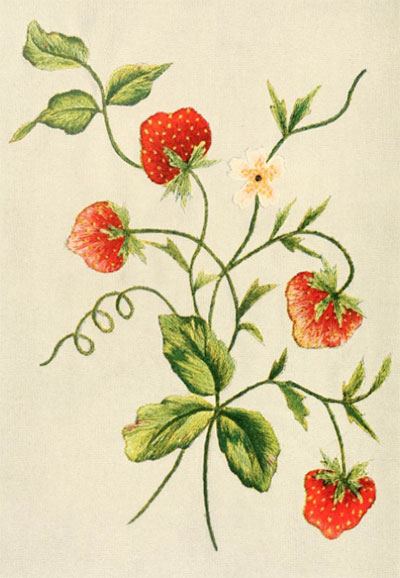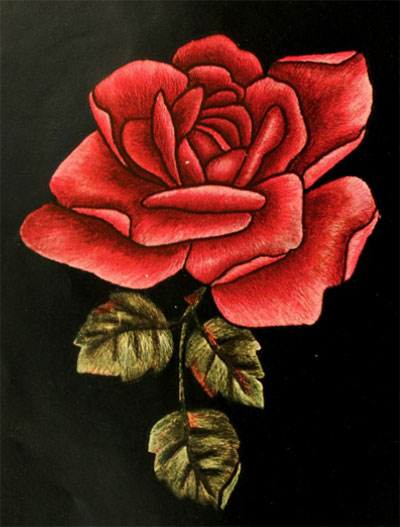For your weekend reading, you might enjoy an old book, published in 1911, about Art Embroidery. But it’s an old book with a twist.
I think it’s an interesting twist, and I think you might find it interesting, too!

Just glancing at the photo above, I’m reminded of Society Silk embroidery – or “Silk Art Embroidery” – from the early part of the 20th century. This is the type of embroidery that contributed in part to the boom of silk thread mills in the US, mills like Beldings, Hemminway, Corticelli, and the like, all of which ended up, in one way or another, combining forces and then eventually petering out.
Society Silk petered out, too.
If you want to read a little bit more about Society Silk, you can visit this article, which focuses on a very nice online resource for Society Silk photos, as well as this article on Society Silk, where Donna Cardwell, author of the book Silk Art Embroidery, answers some questions about Society Silk.
Back to the book, though!
I was enjoying a squizz around Internet Archive, meandering through embroidery-related books, when I came across this book titled Singer Instructions for Art Embroidery.
It was published in 1911. And sure enough, those strawberries up there are machine embroidered. According to the photo caption in the book, they were embroidered with a standard Singer home sewing machine without special attachments. Pretty impressive, for 1911.
The book features many types of embroidery. In fact, if you’re familiar with the old Hemminway or Belding books on art embroidery (done by hand) and the like, this booklet will look a lot like those published by the silk thread industry.

You’ll find information in there on drawn thread work, on many types of lace making, on shaded embroidery, including shaded embroidery on velvet like that pictured above.
*Sigh* If only Singer had met Elvis…just imagine!
The Singer company was masterful at marketing. The whole early sewing machine industry being fraught with patent disputes and the like, it was the Singer company that eventually brought it all together and got the sewing machine out into people’s homes.
Their marketing ploys had to appeal to the women who were doing handwork, and with Society Silk all the rage, it stands to reason that the Singer company would trade a bit on what the silk industry was doing with their instructional booklets. This particular booklet is a good example of that.
Singer Instructions for Art Embroidery is interesting for the hand embroiderer, too. There’s a lot of information in there that applies more to hand embroidery than to machine embroidery and plenty that can be adapted back to hand embroidery, from when it came, anyway.
You can find the book in flip format here:
Singer Instructions for Art Embroidery on Internet Archives
The images in the book are clearer if you can view them in the flip format online. You can also download a PDF (in color or black and white), but the images are decidedly less clear.
And if you want to get lost for a few hours of exploration this weekend, you might enjoy browsing through their ebook and text collections, with the search results for embroidery. Careful, though! You might not resurface until Monday!
Hope you enjoy it! Have a swell weekend!







Amazing. Strongly reminiscent of the monograms you were supposed to be able to make with the buttonhole attachment-presumably because of its zigzag capabilities. I can’t imagine actually doing it well enough to make it worthwhile, but for women dreaming of embroidery brought in to the world of machine sewing before there were even zigzag machines, it must have been enticing.
I love those other old Singer attachments too, although judging from the rarity of some of them, they weren’t necessarily all that easy to use or practical either.
About 25 years ago when I was looking to buy a new machine, the man demonstrating a new Singer did some embroidery, using the free-motion quilting technique. Very impressive! Silly me, I thought I could do the same. =) I did buy the machine but never could do what he did. I know it can be done, but I don’t even try and go through the hassle — I much prefer hand embroidery! Thanks, Mary for your guidance and inspiration.
Laughed out loud at the Elvis comment! Almost spilled my tea! Thanks for all you blogpost. I am new to needlework and have learned so much!
Dear Mary
Late today was out for lunch with a friend. Anyway. I will have to browse through the links on the Singer Instructions for Art Embroidery over the weekend, it looks like and interesting book. I really like the strawberries and I can’t believe it was machine embroidered. Thanks for sharing the links to Singer Instructions for Art Embroidery and for sharing the history of Society Silk, I hope you have a great weekend too.
Regards Anita Simmance
Amazon has the old manual for sale, listed with a 1989 publication date. I couldn’t find my copy. It’s edited by Robbie Fanning, a most energetic teacher in the 1980’s. She also wrote The Complete Book of Machine Embroidery (1986). This was a little before digitizing and machines that cost more than cars, which let you go make tea while they “stitch out” a canned design. I’ve kept my Bernina 930. I was shown how to manipulate the scallops and other basic stitches so as to turn corners and edge collars with everything looking good. One Bernina magazine showed wedding gowns made in Iran on a Bernina which looked like rayon satin stitch on organza — entirely manipulated by hand! Yes, needle in, needle out, move over to . . . just there! and needle back in! This work is intense! It can be done on a treadle machine! They do it in Third World countries when they don’t even have electricity! It takes patience and a huge desire to make something beautiful. Or put food on the table. Or both. I don’t draw, so I have to look for designs. Or just draw anyway! I deplore all the marketing which tends to erode individual confidence. I think we are all designers and what we like is just fine! Also, it is sometimes quickest and joyfulest to just grab some colored floss, thread that needle and DO IT! By hand.
Hi Mary,
I do not comment often enough to say thank you for your wonderful articles each day. I so look forward to reading them. These vintage book are so lovely. Thanks for sharing them.
Chris
Interesting reading about Singer, Mary. I have my grandmother’s Elgin treadle Sewing Machine and the books for it talk about how to do embroidery, but I have not tried it. Knowing that one can sew and forwards depending upon the way the treadle is operated, it would be a good challenge, but still faster than needle and thread. I have some ancient antique thread to use as well so maybe if I get a minute next week I’ll attempt something. The feet and bobbins wee not interchangeable back then, but fortunately I have all the attachments including a ruffle and an early button hole attachment. It’s funny though, I never think of buttonhole stitch for creating buttonholes, but as a decorative edge stitch. So many of the stitches used for embroidery had practical uses in everyday life before machine sewing took over the industry. From net mending, to lace making, let alone straight stitch sewing and edge finishing. At least if the lights go out, we can still have beautiful things to wear!
As a machine thread painter, this book is a gem to me. Sometimes I even wish I had an old treadle singer to have more control over the stitches, as today’s machines are often a bit fast for really fine stitching and the foot pedals are not as easy to control as the treadle was. I notice one of the ladies said she was sold a machine especially for thread painting. Any machine can threadpaint. All it is is straight stitch, so the older the machine and the less modern additions the better.
All I have to say is WOW! On a 1911 Singer! This is so interesting – thank you!
Dear Mary,
I have thoroughly enjoyed reading this – although I do not want to do machine embroidery, there are interesting tips and discussions. On many of the finishing instructions for machine-lace, the reverse of the lace is to be brushed with gum-arabic – of differing dilutions depending on the embroidery – and not ironed. One even specifies pinning the embroidery to a pine table.
There are several mentions of Battenburg rings. Do you know what they are?
Regards,
Helen
They’re the little “rings” that are used in Battenburg lace, Irish crochet, Hedebo, and the like. They look like little rings covered with buttonhole stitch and they’re used for accents and to join different areas of filling and so forth.
Thank you for the answer. I didn’t know that the rings could be purchased ready-made. I doubt that that can be done today.
I don’t know if there is c current interest in making machine lace on a home sewing machine. It sounded daunting. I would expect someone doing hand-embroidery would want to do his or her own.
Regards,
Helen
I just bought a 1989 reprint of Singer Instructions for Art Embroidery and Lace Work. It was originally published in 1922. It has 124 lessons in it. Great reference book as it shows examples of many different types of embroidery and Lace. After glancing through it, it looks like it might be easier to just do good old hand work.